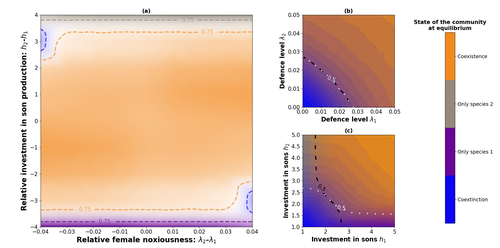


Mimicry between species has long attracted the attention of scientists. Over a century ago, Bates first proposed that palatable species should gain a benefit by resembling unpalatable species (Bates 1862). Not long after, Müller suggested that there could also be a mutual advantage for two unpalatable species to mimic one another to reduce predator error (Müller 1879). These forms of mimicry, Batesian and Müllerian, are now widely studied, providing broad insights into behaviour, ecology and evolution.
Numerous taxa, including both invertebrates and vertebrates, show examples of Batesian or Müllerian mimicry. Bees and wasps provide a particularly interesting case due to the differences in defence between females and males of the same species. While both males and females may display warning colours, only females can sting and inject venom to cause pain and allow escape from predators. Therefore, males are palatable mimics and can resemble females of their own species or females of another species (dual sex-limited mimicry). This asymmetry in defence could have impacts on both population structure and community assembly, yet research into mimicry largely focuses on systems without sex differences.
Here, Boutin and colleagues (2023) use a differential equations model to explore the effect of mimicry on population structure and community assembly for sex-limited defended species. Specifically, they address three questions, 1) how do female noxiousness and sex-ratio influence the extinction risk of a single species?; 2) what is the effect of mimicry on species co-existence? and 3) how does dual sex-limited mimicry influence species co-existence? Their results reveal contexts in which populations with undefended males can persist, the benefit of Müllerian mimicry for species coexistence and that dual sex-limited mimicry can have a destabilising impact on species coexistence.
The results not only contribute to our understanding of how mimicry is maintained in natural systems but also demonstrate how changes in relative abundance or population structure of one species could impact another species. Further insight into the population and community dynamics of insects is particularly important given the current population declines (Goulson 2019; Seibold et al 2019).
References
Bates, H. W. 1862. Contributions to the insect fauna of the Amazon Valley, Lepidoptera: Heliconidae. Trans. Linn. Soc. Lond. 23:495- 566. https://doi.org/10.1111/j.1096-3642.1860.tb00146.x
Boutin, M., Costa, M., Fontaine, C., Perrard, A., Llaurens, V. 2022 Influence of sex-limited mimicry on extinction risk in Aculeata: a theoretical approach. bioRxiv, ver. 2 peer-reviewed and recommended by Peer Community in Ecology. https://doi.org/10.1101/2022.10.21.513153
Goulson, D. 2019. The insect apocalypse, and why it matters. Curr. Biol. 29: R967-R971. https://doi.org/10.1016/j.cub.2019.06.069
Müller, F. 1879. Ituna and Thyridia; a remarkable case of mimicry in butterflies. Trans. Roy. Entom. Roc. 1879:20-29.
Seibold, S., Gossner, M. M., Simons, N. K., Blüthgen, N., Müller, J., Ambarlı, D., ... & Weisser, W. W. 2019. Arthropod decline in grasslands and forests is associated with landscape-level drivers. Nature, 574: 671-674. https://doi.org/10.1038/s41586-019-1684-3
DOI or URL of the preprint: https://doi.org/10.1101/2022.10.21.513153
Version of the preprint: 1
 , posted 15 May 2023, validated 16 May 2023
, posted 15 May 2023, validated 16 May 2023Dear Authors,
I apologize for the time it took to reach this point. It was extremely difficult to find reviewers, and I was out of my office for most of these last monthts.
After reading your article and reading the recommendations from the two reviewers, I would like to advince for a revision of your article.
The 1st reviewer raises some minor points, but some of them do not look so minor to me. The revision should address these points carefully.
I have also read your paper in some detail. I mostly agree with referee comments. They make a number of generouos and constructive comments.
However, although you say that all your work was numerial work (based on numerically integrating your ODE systems across a range of parameter values), I believe some analytical work is worth trying. If you take the system 10a-10b, it is a 2D system representing the dynamics of the female and male subpopultions for a single species. This system seems to be simple enough to be amenable for some analytic treatment. For instance, Fig 1 summarize the main results from this model. There you can see a strait line separating extincion (black area in a bottom left triangle) from maintance (shaded in a gradient of colors) of the population. Do you think this line can be predicted by calculating the stationary points of the 2D system?
The 2nd reviewer seems to convey that such an analytical work is not possible, which is probably true for the more complicated 2 species model, but I just think that there should be some limits in which analytic results are surely possible. It would be nice if the authors could give it a try.
In sum, pay attention to the detaild comments of the first reviewer, and consider to extend your numerical work with some analytic or semi-analytic results, at least, for the one-species 2D model.
Apart from that, if these issues are adressed, I agree with the reviewers that this paper will be a very nice piece of work I would recommend.
I promise to expedite the reviewing process of the revised version as soon as you re-submit it by asking the same reviewers for a look to it in the most quick way possible.
David Alonso